I went on a residency in France
Gabrielle de la Puente
At the beginning of April, I ran away from home. I told my boyfriend what I was planning because I love him and I always want to be polite. Although, I only gave him the broad strokes, the base coat, the outline — that a stranger called Nathalie had invited me on an artist residency in her renovated mill in the South of France, somewhere rural, set beside a river and a waterfall, and would I like to come? We emailed, I called. The residency was new and if I were to cover what was happening over there, our audience might be interested in coming on that residency too — fair. But I remember opening the website for The Mill and closing it straightaway because I’d already decided I’d rather be anywhere else than here where I always am. I used to be somebody with year-round travel insurance, stray euros and Norwegian krone at the bottom of my bag. My boyfriend once gave me a gold-covered map and a one pound coin so that I could scratch off the places I was always going. One day, the whole world would be my jackpot! But in these past three years of chronic illness, the only thing I’ve scratched is a hole in the map where I live; spinning my wheels in a sick bed, quilts getting ragged by the tires.
This email came at the right time. Lately I’ve been able to walk further and for longer, not without pain or risking crippling headaches, but further and longer nonetheless. I closed The Mill’s website because I wanted to try being sick somewhere else. That and I’d had an idea for a book recently and this suddenly felt like the only way I could start it. Plus, if I was going to be paying for trains to Manchester and a hotel in the airport and return flights to Béziers with Ryanair’s baggage pricing; if I was going to be coaxing this body through sharp airport doors at 5AM, carrying bags like Buckaroo, and squeezing myself into a budget airline seat; and if I was going to be moving timezones, and driving with a stranger for an hour and a half to a place called Saint-Georges-de-Luzençon — a stranger I hoped was real and not a figment of my own wish fulfilment, to start a book, really test the strength of my body, and get closer to scratching off that 100% jackpot and perfect completion of the continents, the cities, and all the places in between — well, then, I wanted to discover every detail as it happened. The email was already saying too much. I couldn’t look! Just booked my flights, ran away from home, and didn’t know enough to worry so I never ever did.
Two hours in the sky to arrive an hour in the future, Nathalie picked me up from the smallest airport I’d ever been to. She was real and she reminded me a bit of my Mum. That is, if my Mum had aquamarine eyes, a southern accent, and was a multi-hyphenate bilingual interior architect-ceramicist-designer who had decided to suffer London no more, quit her job, taken out loans and bought an old flour mill in the French countryside. I was distracted by that same countryside as we spoke. I had never been to the South of France before and I thought it was going to be flat. I suppose I imagine the south of every country as being flat now that I come to think of it. Northern mountains tiering down into cliffs and hills. Hills tiering down into flat expanses that crumble into coasts and then nothing. But we were driving so high that my ears were popping; a body-thing I hadn’t felt in so long it had become novel again, and fun.
As we drove, we spoke about books, films, and the dinosaur footprints a neighbour had found pressed into rocks 200 million years ago near to where we’d be staying. Nathalie told me her reasons for making such a huge change in life, and they were simple enough. She wanted to live somewhere with real seasons. She needed space to make art. She wanted enough space to accommodate other artists, because it was important to her to serve others. If other artists were being served, then so was she. Alone or in good company, The Mill would be a place where she could live an artistic life. I was nodding, agreeing, unsure I could do the dinosaur hike on my legs, and half-wondering if I should take out loans so that I can do something I wouldn’t be able to with my current bank balance. I am so worn down by illness and England and how expensive it is to live the most basic life that I’ve lost the capacity to imagine anything better — and when I meet people who do have something left in the tank to move countries or change jobs or close one chapter and start another, I instantly feel as though they are daring me to do the same.
From the car, Nathalie pointed out a bird of prey flying overhead, ancient ruins from the days of the Knights Templar, and road signs that had been unscrewed, flipped, and screwed back on upside-down by farmers protesting the French government’s hypocrisy. Everything was exciting me, like the ear-popping, and I don’t think I’d been excited in a long time. I remember passing villages clustered in valleys below us, the buildings made in lighter shades than ours, far enough away that each looked like ceramic decorations or toy towns. I imagined the people who lived there rolling their eyes and turning me upside-down for all my romanticised descriptions. I would let them! So passive, so tired, when we drove below a white Norman Foster bridge that stretched impossibly across a gorge over the nearby town of Millau, it seemed obvious to me that the viaduct had been placed there by alien technology. We are far too small and useless to make things like that happen. But then I think all sorts of wrong things. I think there are no mountains in the south; and I seem to think you have to play the hand that you’ve been dealt.
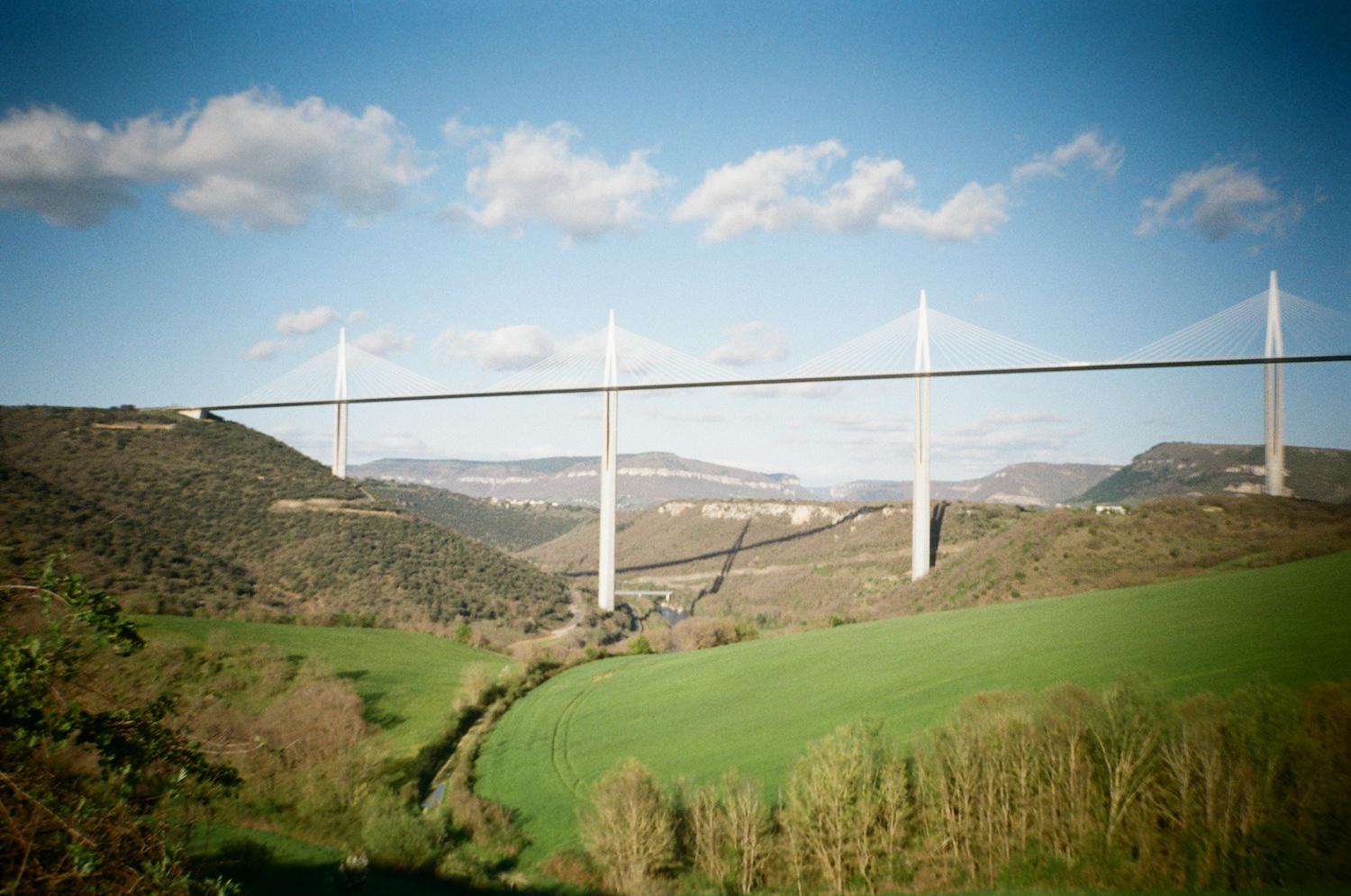
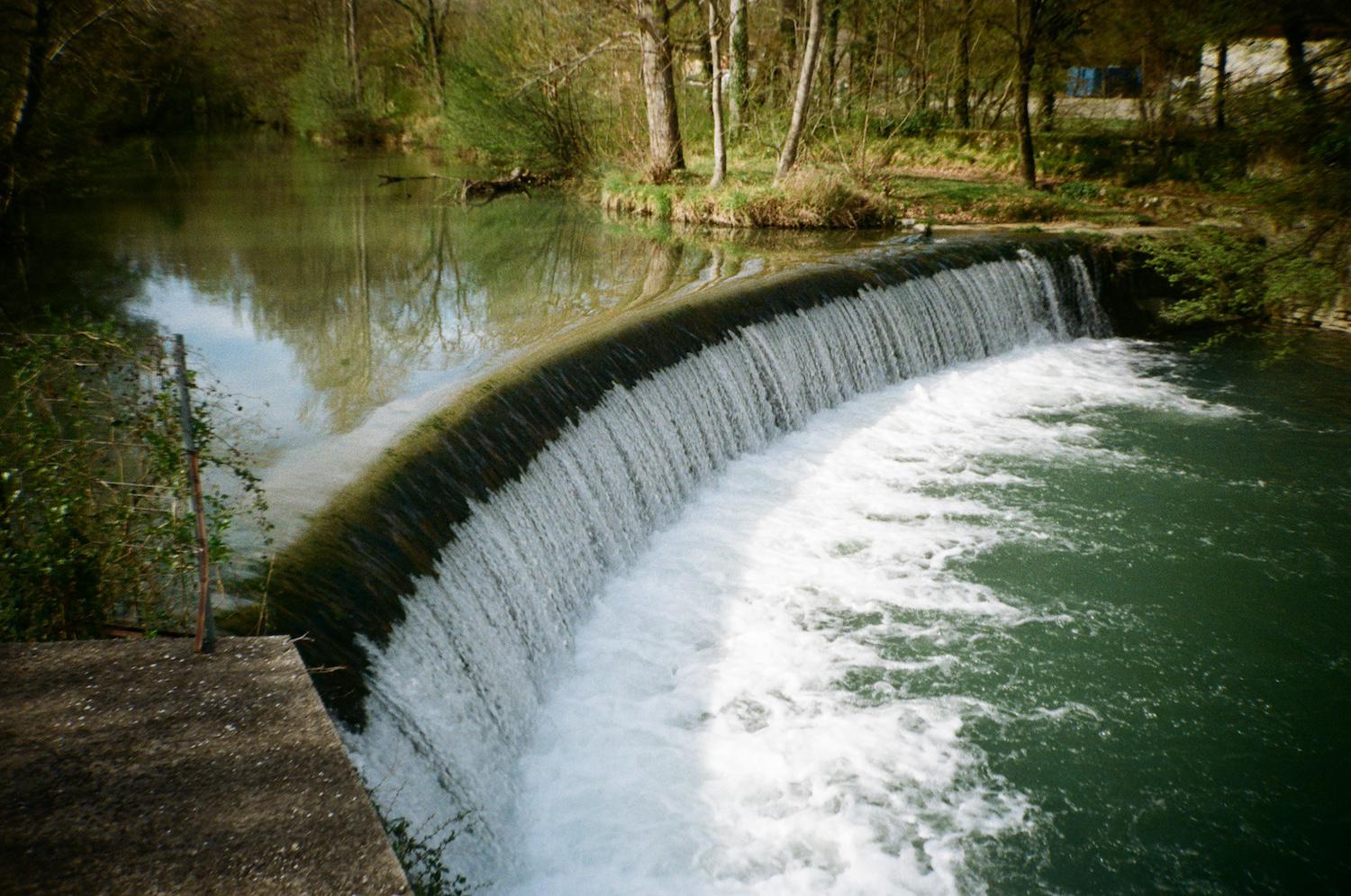
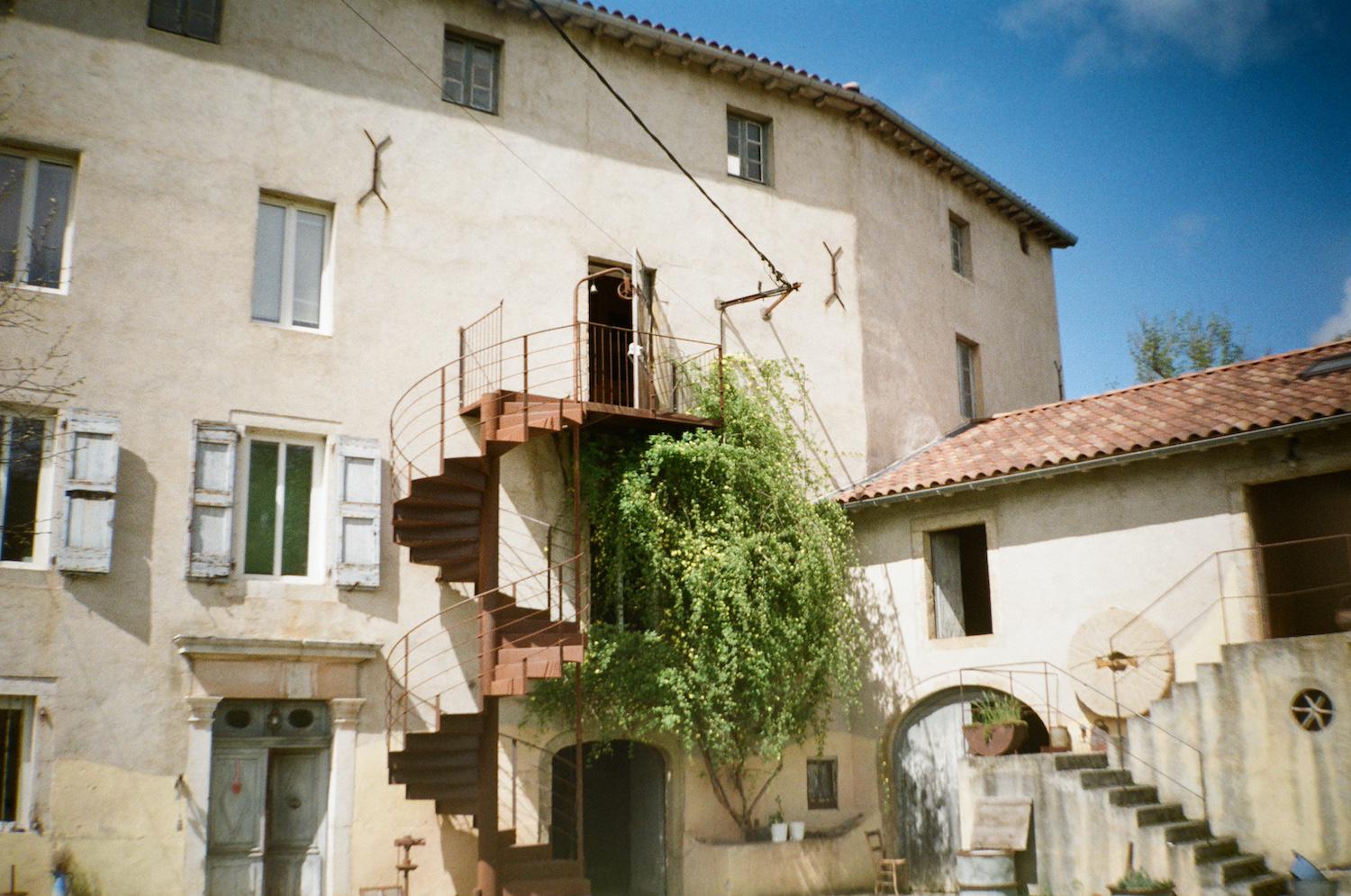
Well, we arrived and The Mill was also real. And there was a waterfall. Wider than it was tall, fast and curving like a pleated white skirt dressing the river’s waist. Long grass, blossoms on cherry trees. Tulips, an outdoor bath. Two swings in two trees. There was a huge ceramic and print studio with a scrap yard to the side, where the biggest cat I’d ever seen was prowling past the firewood. Ahead, the main building was four storeys and it was like an Architectural Digest shoot inside, but only after the cameras had left. The place, full of design, was more homely than a photograph. Lived-in, functional, and still full of beautiful points: an assortment of mirrors in place of a backsplash, flowers picked fresh from the garden, and on top of a cabinet, a mother of pearl thimble case shaped like an egg just because it’s something nice to look at. Style has always seemed like a thing I’ll get around to if and when I have enough money, another thing I’m wrong about. Decoration was like confection here, and I wished this was my house. My absolutely massive, perfect house.
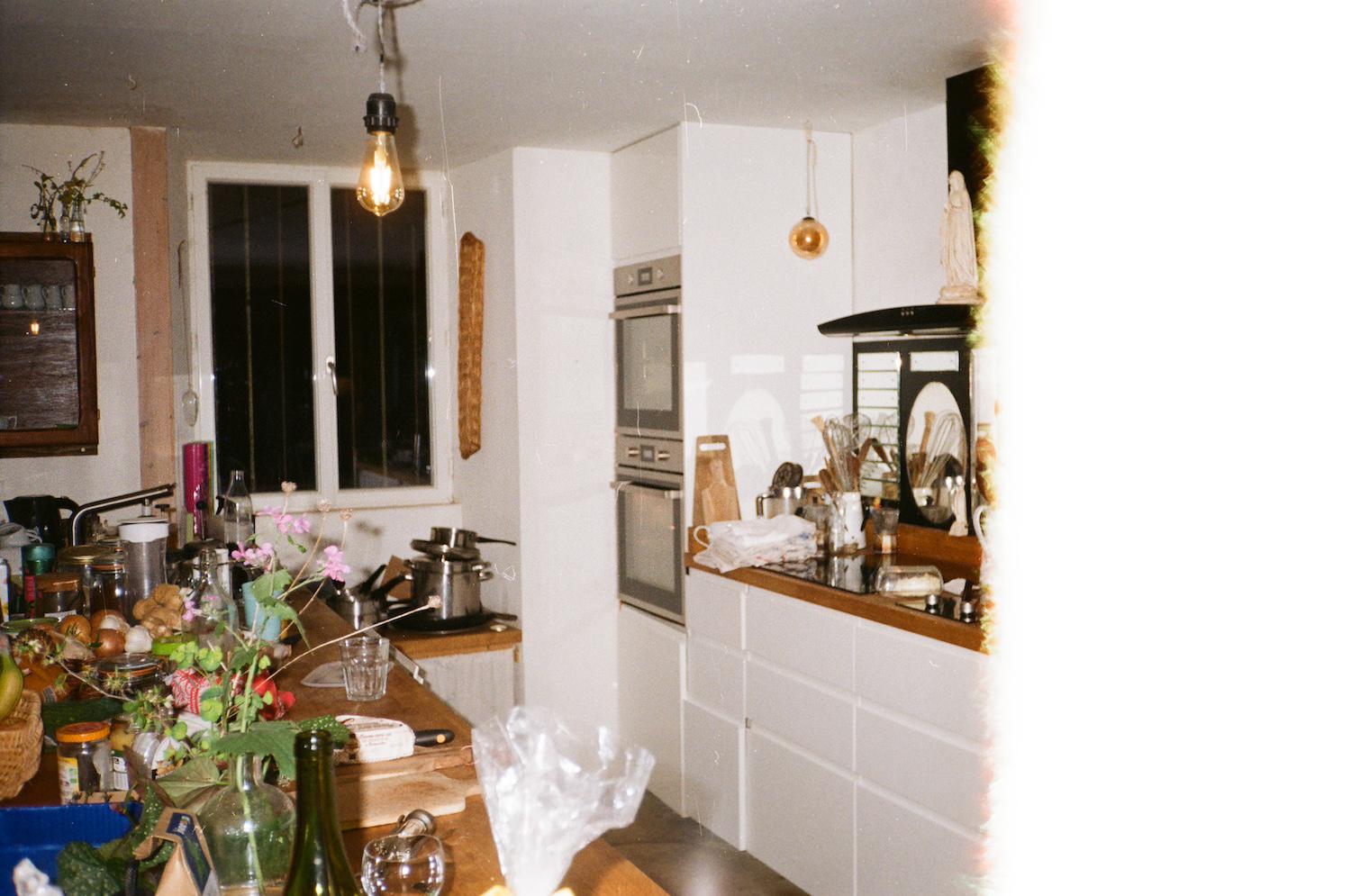
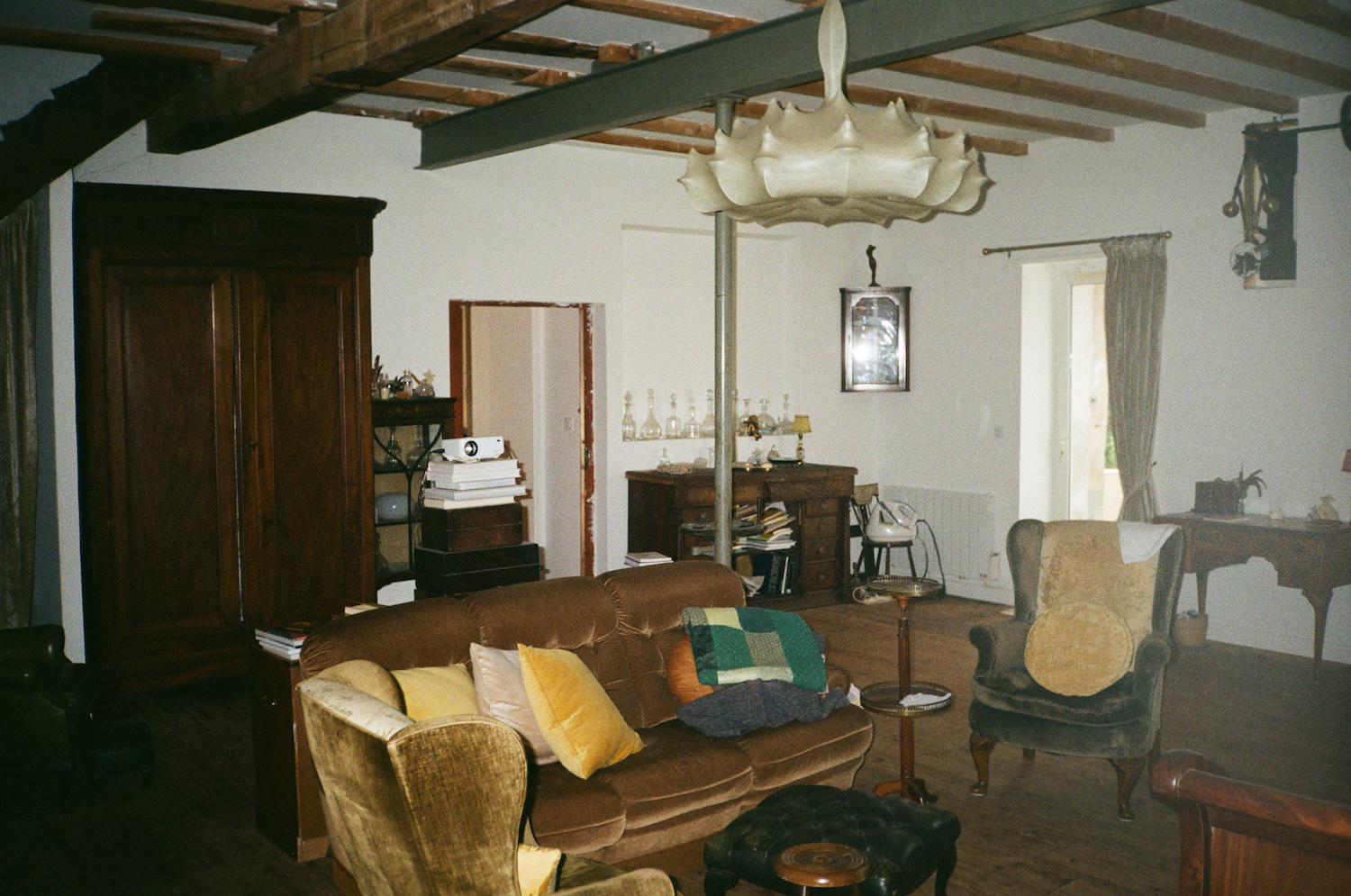
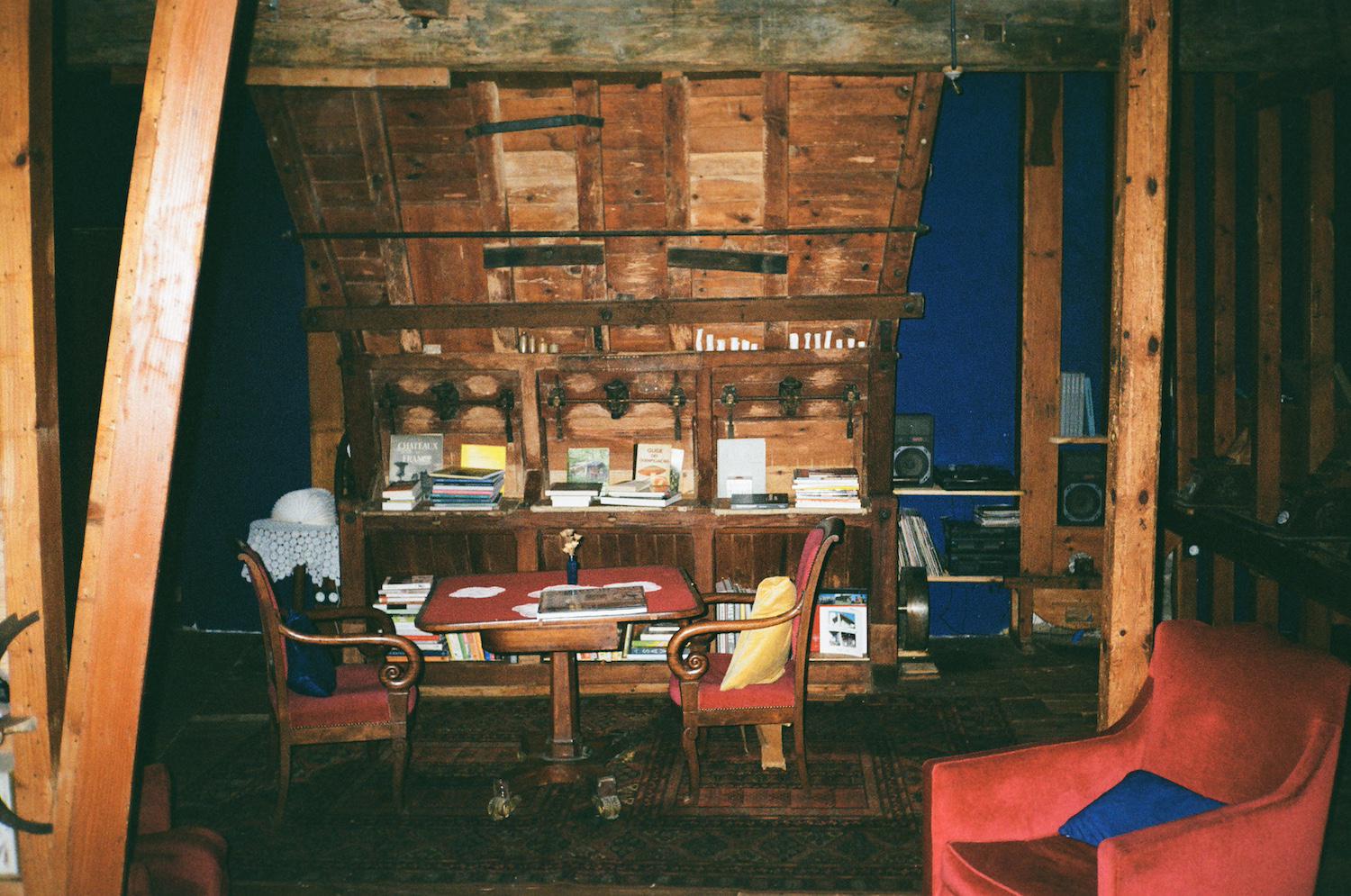
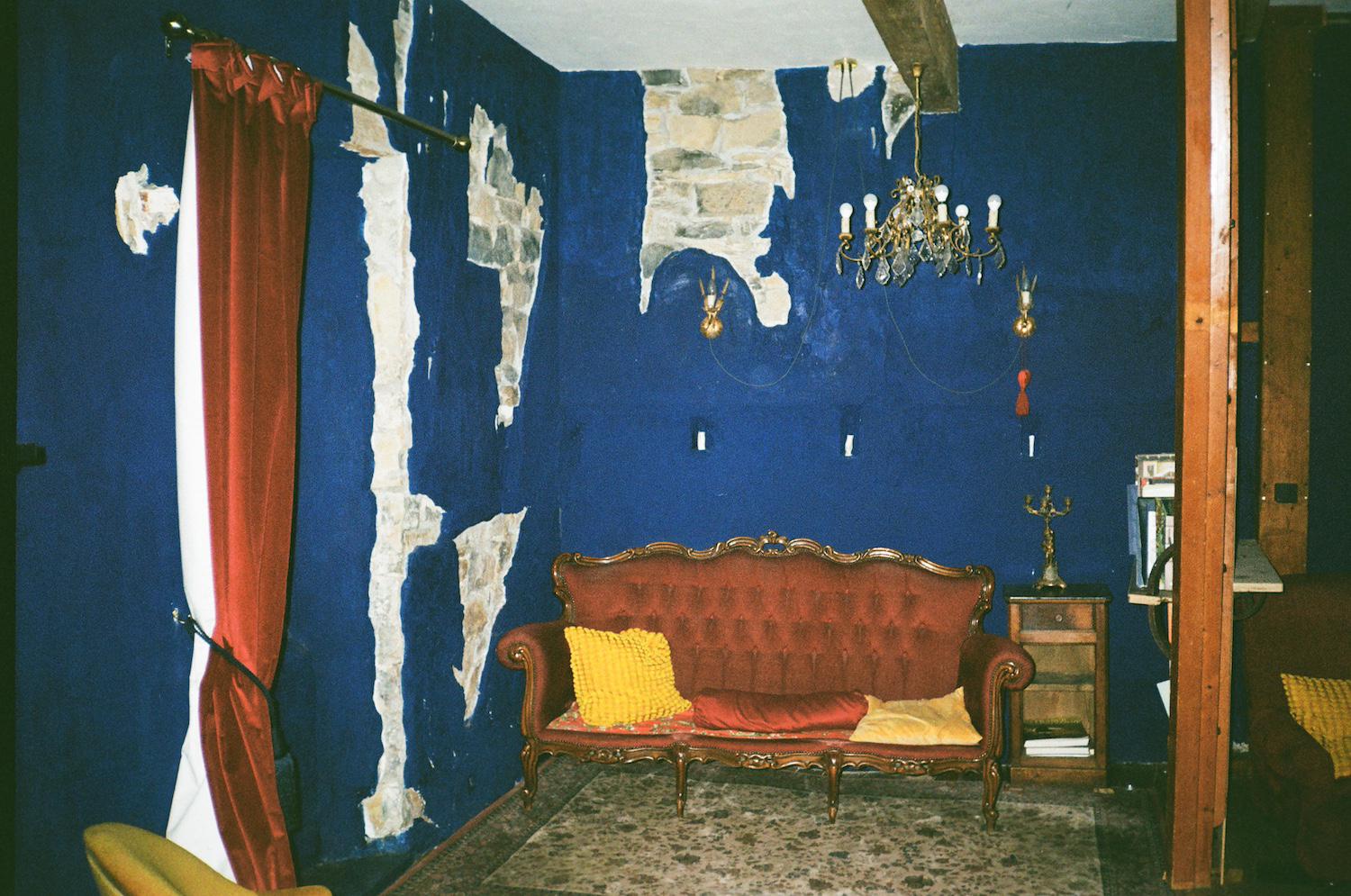
Each of the six bedrooms looked like the product of a different, laboured mood board. Mine was pink and white, crochet throw, rose quartz. The hangers sounded like wind chimes as I emptied my suitcase of clothes and carried on exploring the site. Next to my room, there was a salon full of velvet furniture and a huge antique day bed. The salon opened onto a balcony that was bigger than my living room back home. Another door led to the library, painted matte with blue pigment and lifted with gold chandeliers. There were vinyl records, and books on art, architecture and fiction. The space was ornate but cut by The Mill’s original architecture, with heavy wooden chutes the grains used to fall through. Off the library, there was a barn-like event space and — I just felt tiny in there, as I did by the river, under the trees and the sky, or round the back where a stream carried on underneath the house so that nature was so completely around us. I liked feeling small, liked having too much space around me, and that was even with so many of us staying there.
The residency scheme that Nathalie had invited me on was called Co-living For Creatives, in which a maximum of six individuals, in or out of collaborations, can pay to stay at the mill for a month. A few of us were there to test-drive it for a week (a bit like that period in marketing when all the beauty influencers were getting flown out to tropical islands to help sell the latest mascara, except not like that at all, because I’m too interested in protecting my audience’s interests and eyelashes). I was staying at the same time as Paris-based arts writer Tahney Fosdike, Amsterdam artist and gallery owner Anita van Oosterbosch, and two more Englishes: artist Supermundane, and creative director of Private Press Gary Parselle. There’s all this space, a studio, an electric & gas-fired Raku kiln, an Albion Royal printing press, and those books and vinyls to get through. But the residency comes with a social element: putting money into a kitty for the weekly food budget, organising the shopping and the cooking, and eating together. Swimming in the river, watching films on the projector, going on excursions, seeing those dinosaur footprints that one neighbour found; and the general exchange of artists speaking to one another. But in all honesty, the value of being there with other people was not clear to me until the end of the week. I needed to start writing the new book, and until I did so, everything I saw of the place and the people felt like the adverts that roll before a film.
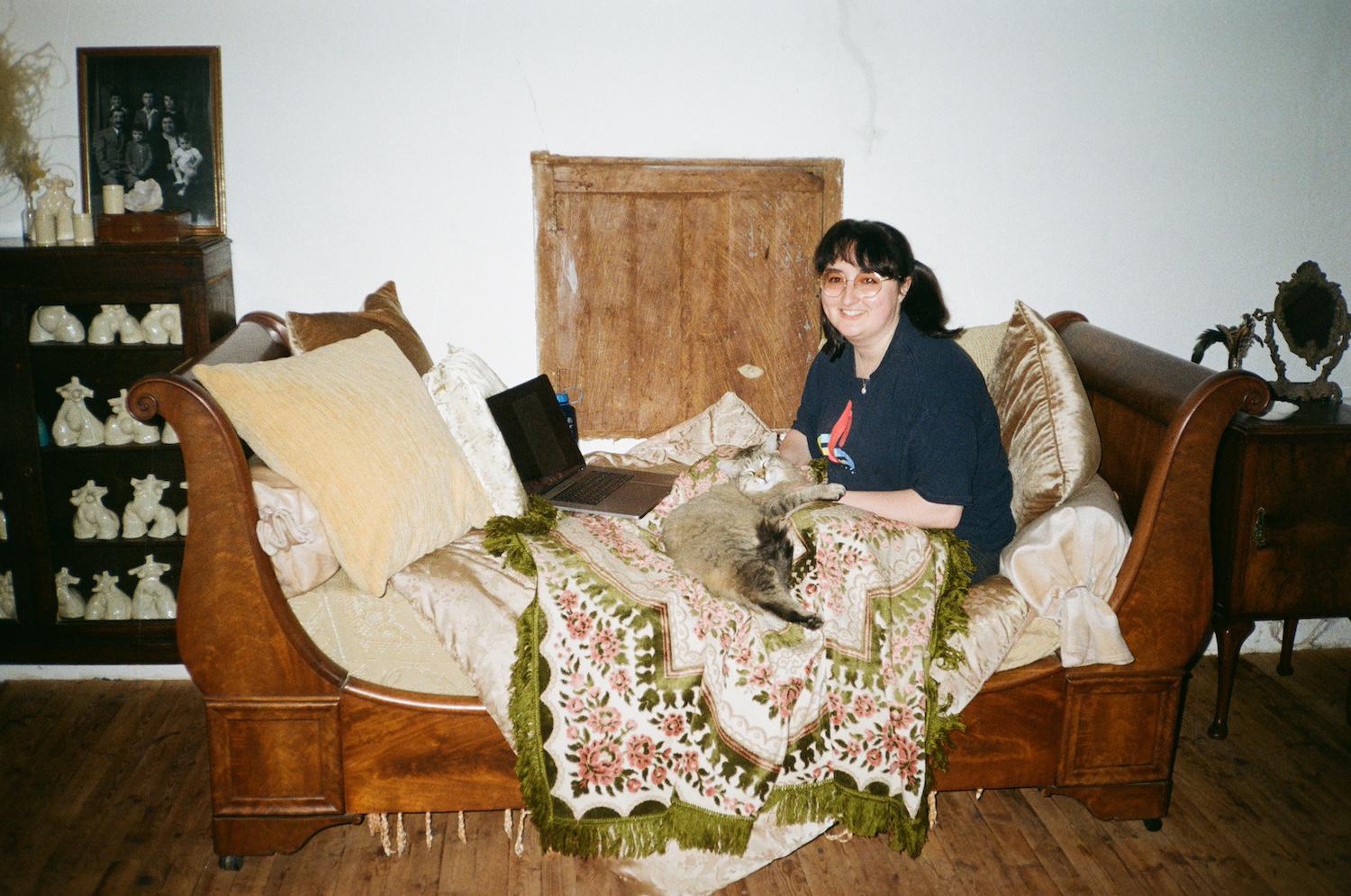
On the very first day, we ate a Niçoise salad together and I gulped apricot juice, before slinking off to the balcony. It was afternoon but I felt like a kid who’s been told they’re allowed to stay up late tonight. I settled into that sun trap like a cat, opened my laptop, and began to write. Over the course of the week, I burrowed under the blankets on various day beds, and lost time in the swing one afternoon, entertained by a green lizard with a blue head running back and forth in my periphery. I took a notebook and walked to a bridge so that I could sit on the other side of the river. I waited for ideas, and also for branches to slip down the waterfall. I’d go back to the swing at night when it was too dark to see the water, or the ground below me, so that I was floating somewhere and nowhere — and that was my favourite state. I also wrote from bed. Happy that it was a different bed, and waking up much earlier than I ever do at home. I was surprised at 6AM when I could still hear the waterfall, as if the river should have waited for me; I would have liked to have seen the world turn itself on.
It seems like such convoluted behaviour of artists and writers to go on things called residencies in order to produce new work. I should be able to do that work at home. I’m still working on the same laptop either way. But I understand why we do it. When I’m existing in the place I’m from, the world drains some element from me. Takes something, like I’m constantly forcing my way upstream and the city is stronger so it’s always pushing me back. When I’m in a new place, I can sense that new place giving me something. Filling me back in, no resistance. I stop seeing the original place where I live because I already know what it looks like, but I don’t know this new place so I have to see everything. My eyes are open again, and my brain is turned on, and once my body is activated, ideas return and I can start to do the work of stringing those ideas together — which is how I make my art. I’m not even relaxed at home, I think it’s closer to stasis. Fine but not good, like the moment before you take the next breath. Things would be a lot easier if I was the kind of artist who could stay in one place for so long they fall through the hole they’ve scratched in the map and right there, on the other side, are all their best ideas. I really have to chase mine down. I kind of have to run away from home.
As a writer, I tend to be the type who produces a lot more than I need. But whittling down the words and making cordial of it all is half the fun. Apricot syrup. In The Mill, I wrote three paragraphs on the balcony on that first day and I decided to spend the rest of the week editing that single page of writing. One page! All that way for one page. God, I was so pedantic with myself. So slow and obsessive. It was like fine-tuning a scientific instrument, or practising the same golf swing ten thousand times, or sewing a seam and then unpicking it stitch by stitch, realigning the fabric, and going again. It wasn’t painful. It was satisfying, wringing those three paragraphs tighter than I’d ever normally go, or get to go. I thought about how much I rush through texts to meet deadlines. How much of my writing is about communication, and how I wish it was more about art and less about making sense. In the residency setting, I changed gears in private to see if I could handle it. It was good for me. Good to be indulgent. Good to watch my writing developing as a result of the focus, and the setting, and the river, and the conversations we were having around the dinner table, and The Mill’s feeling of grandeur that made me want to match it.
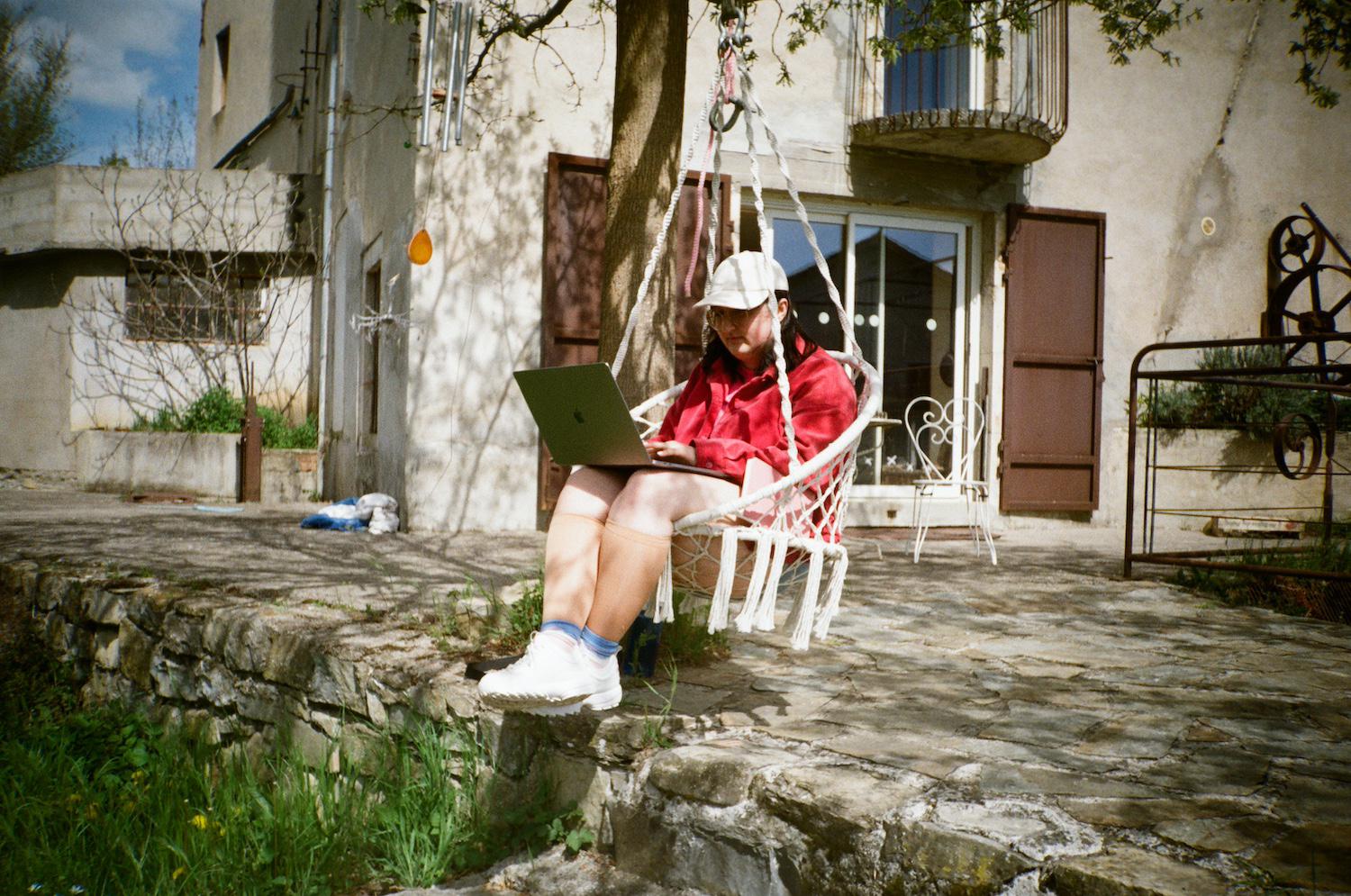
And it was immediately bittersweet because I was only going to be there for a week. I was also feeling the art-equivalent of survivor’s guilt once again for enjoying the opportunities thrown to me for being a critic with a significant readership. Something about the whole thing just seemed so ridiculous, and I don’t mean the act of leaving home to go somewhere else to hone your artistic skills; but that it should be so difficult to access this sort of golden window of time that places like The Mill can offer. The mirage of it all; being plugged into a life support system with dinner on the table, a proxy family to check in and encourage you, fresh air, grass to touch, and the peace and quiet to listen to your own thoughts and feelings and therefore to think more deeply. The artists I know never get to do these kinds of things. Artists apply for paid residencies that sometimes come with bursaries, and never get accepted because they haven’t got the time or space to produce the kind of work, or kindle a career, that would make their application look worthy in the first place; that, or they don’t have the finances or the freedom to take a month off work to go on a self-funded residency such as this one. Everybody is wilting, and for every other week of the year, that’s me too. My sense of growth is so much slower than I can stand, psychologically and creatively held back because so much of my income goes to rent, bills, Tesco, and that’s that.
The Mill is priced at 1600-1800€ for the 4 week stay (£1369-1540 at the time of writing), the higher price being the rooms with en suites. That number does not include pitching in for a shared food shop, using the kiln, or travel there and back. Your reaction to those figures is going to be completely subjective to your position in life. There are pay-to-play offers all over the creative industry and if you can afford them, you’re probably having a lot of fun. But if I wanted to come back to The Mill, I would have to apply for research and development funding. Getting that is not an easy feat in this economy, but it is one option. (I speak to a lot of people applying for Arts Council grants who struggle to list the specific ways in which they are going to develop their practice. A residency like this might help an applicant make a good argument, especially as the co-living aspect expands your network, something the Arts Council like to hear). Other people might look at subletting their own housing and/or studio rents for the month to make their time away a little less financially stressful. If you’re attached to a university, or preparing work for a show, the institution may well pay for you to go. For what it’s worth, Nathalie is hoping to have a subsidised or free place on each residency in the future. Until then, and even after, the path there is extremely narrow.
I think it is worth putting The Mill’s price into perspective. Just this week, Arctic Canvas launched a residency that comes at 3000€ for an individual or a couple to stay in West Iceland for a month. Closer to home, you can stay in an insulated, converted shipping container in Cove Park on Scotland’s west coast for £3000 for the same 4 week span. A few hours from The Mill and over the border, Can Serrat has a similar co-living offer set in a Catalan farmhouse a 40 minute bus ride from Barcelona. Private rooms there are 1347€ for the month, subsidised by the local cultural department. Can Serrat also provides basic food, and cheaper options in shared rooms. If you want co-living and a more rigorous programme of guest artists and curators, crits and a final group exhibition, Porto’s Torrinha programme is 3000€ but it lasts three months. And like, I’m writing this wondering what price I would put on that one page of writing I produced in The Mill and it’s impossible to quantify. I didn’t want any set activities. I wanted to be left alone in abundant space and that’s what I got. Writing is the most important thing to me but there are hard limits on how much I can afford to indulge that importance, so I don’t know where I land. Although I wouldn’t pay £3000 to stay in a shipping container for a month even if I had money to burn.
I realise how weary British artists are three years into a cost of living crisis, with our bankrupt councils, and rising competition for funding. So while I mention these avenues towards affording residencies, and compare prices like I’m actually shopping for them, just know I have never had the mind to Google the kind of escape rope terminology that would have led me to any of these websites. ‘Artist retreats,’ ha-ha, I’m so done-in I don’t think I can retreat from the badness we live with. I’m in England now and it’s only been a week, but my time in France feels far away, like the nicer parts of this text, back when I was describing the mother of pearl decorations and writing in a swing, and before I started getting into the price of entry. I guess broadly I don’t think The Mill, or any of these other residencies, should have to charge less. I just wish artists were better supported to meet those prices. Because you also want to feel like you belong in a place, and you’re meeting everybody and the architecture as an equal, not that you have had to claw your way through the doors or beg, steal and borrow for a bit of peace and quiet. We really deserve so much more from life. We deserve jackpots and good mascara. We deserve to leave this country and relocate to places with real seasons where we can all live an artistic life. The real shame is that when one of us does make it out, we can’t all immediately share in the same relief, because it cost Nathalie so much to get away from the problem in the first place and now she has to recoup those costs.
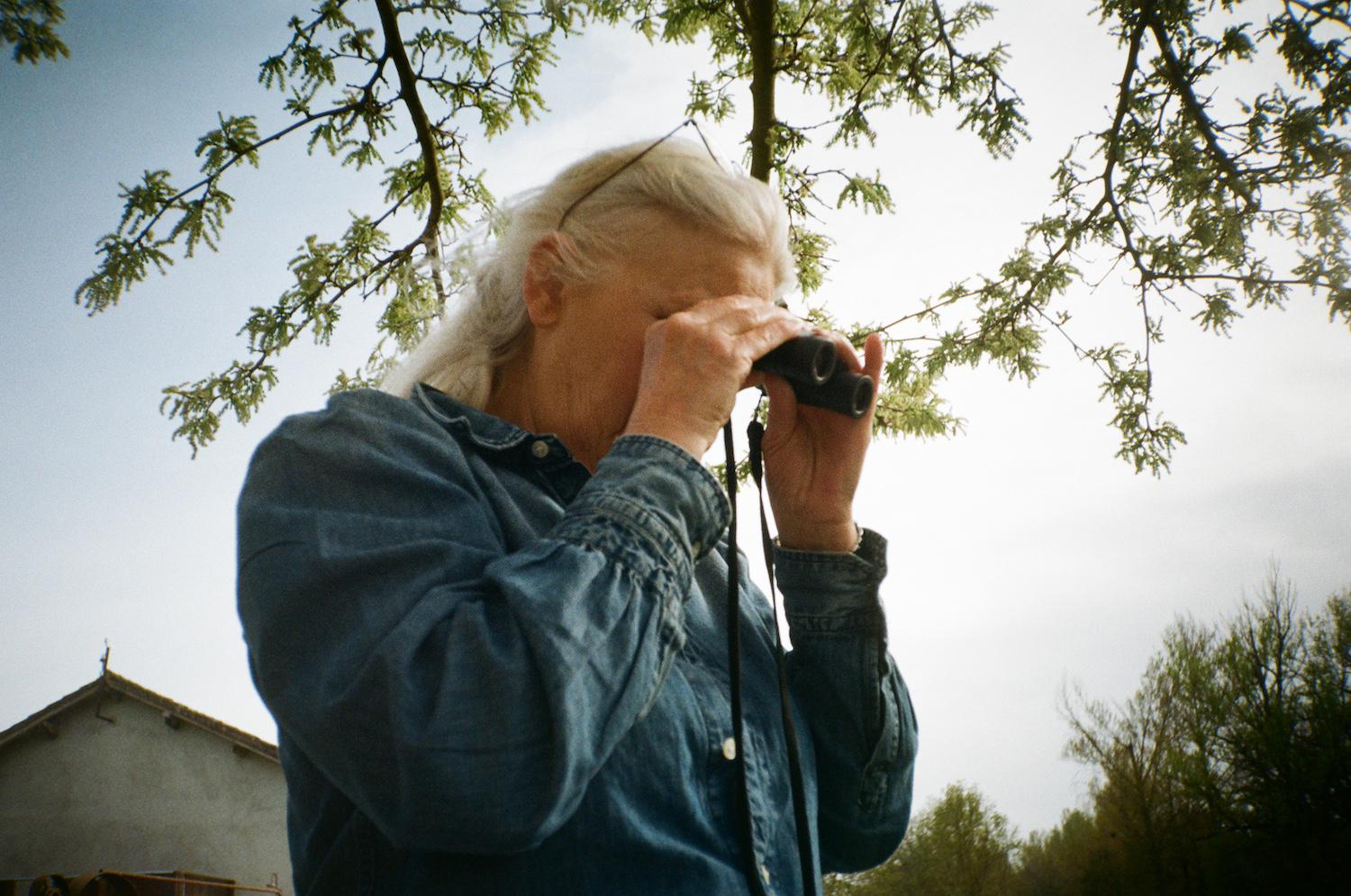
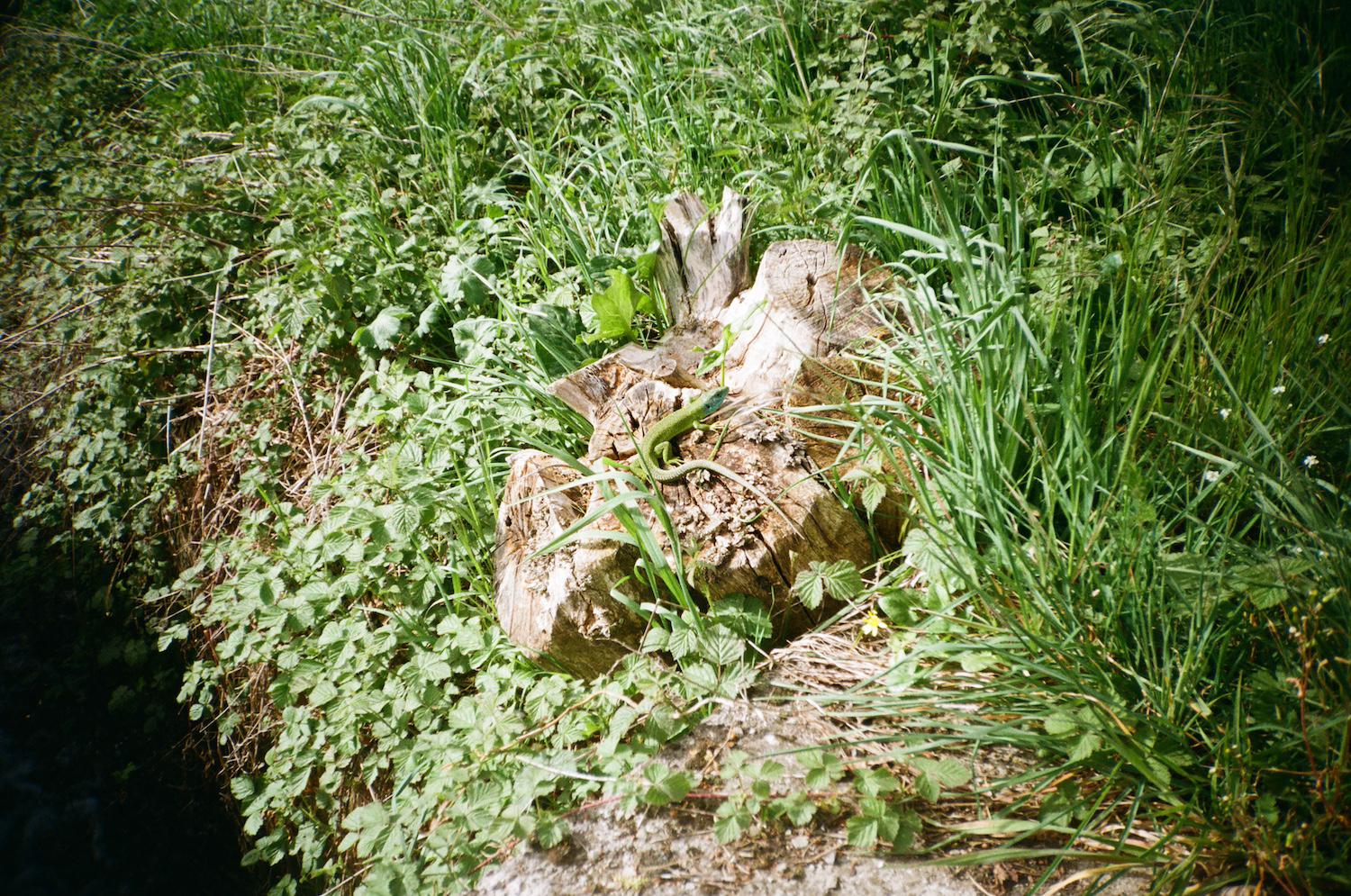
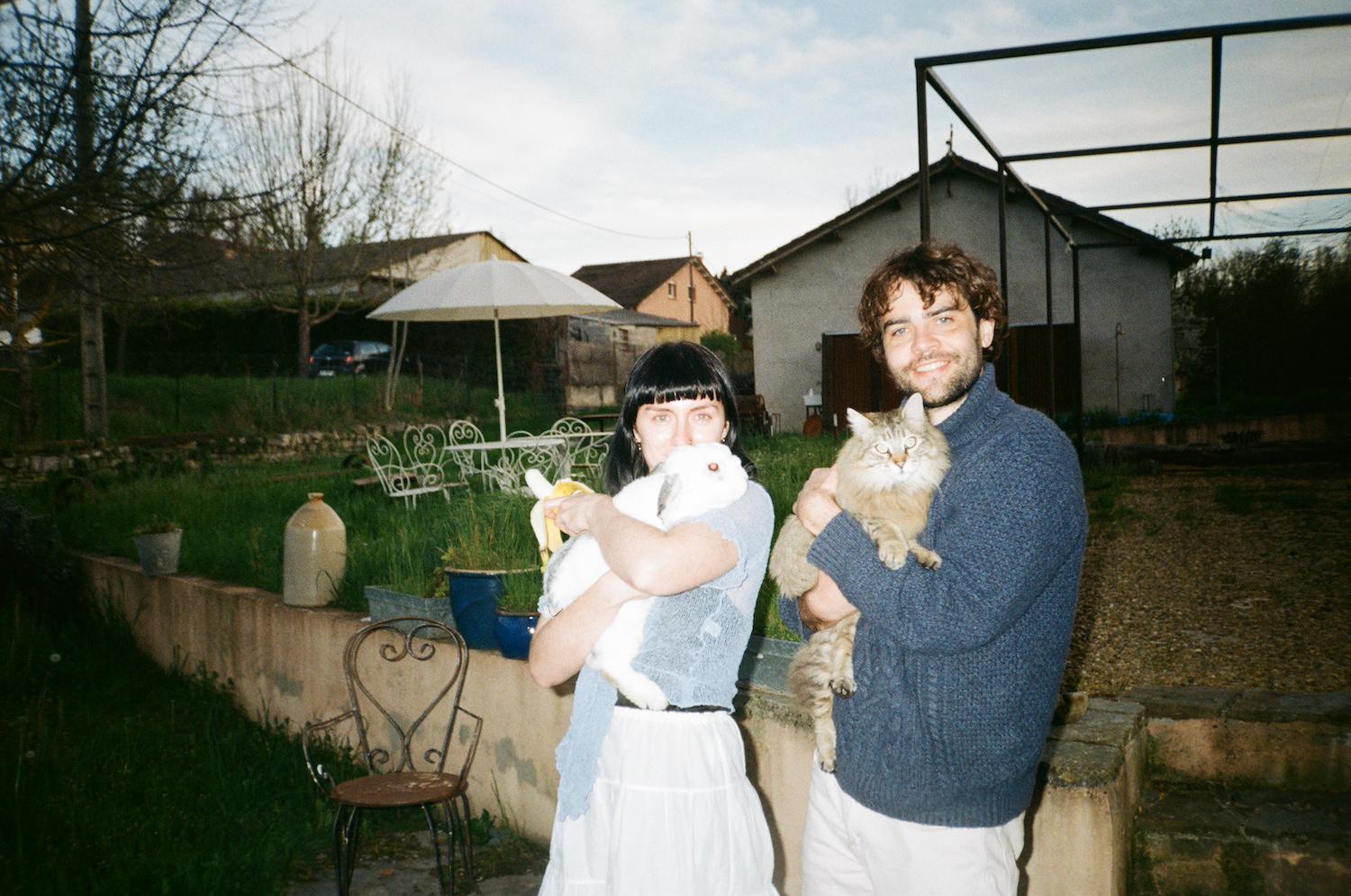
To end, I do wonder how many people will read about the co-living part of this residency and write it off, but I’ll offer my experience as someone who doesn’t have the biggest social battery, but also wouldn’t want to be alone in Iceland for a month because I would fully go mad and you’d probably never hear from me again. I enjoyed it. I made friends. I cried laughing the first night, and I have people to visit now if I ever go to Paris or Amsterdam. I learnt a lot about our cultural differences. For example, did you know France enjoys an hour and a half lunch break so that people have time to digest their food? Espresso is capped at 1 euro 50, around where we were staying people say choclatine instead of pan au chocolat. Cute. Also, 23andme is banned in France because there are so many affairs and the government would rather preserve the peace. These tidbits are the most interesting things in the world to me. When I got home, this is what I told my boyfriend, not the fact I came away from the residency with one glorious page of text.
It’s a huge financial and emotional risk to travel so far and be one of 6 people thrown together like atoms, hoping for the release of new energy, or entanglement, and not nuclear reactions. But I think when you’re also cooking for one another, there’s a baseline of care. Sometimes I daydream about every house taking turns cooking for the families on my road and how, if that were the case, I’d only have to cook once a month. My day might be an ordeal, but once a month would be such a load off my mind. The things I could do with my time! Co-living was a microcosm of that daydream, and I enjoyed sharing it with strangers in particular because if people didn’t know me, then I could drop my own expectations of myself and try out being someone new. I didn’t know I liked fennel and blue cheese, for example. They didn’t know how I dread cooking for others, because I cooked for all of us, twice. I was in a beautiful place doing something that many people would want to do. I wasn’t going to ruin it by being anxious. What would be the point in that? My anxiety is generally a fear of not meeting people’s expectations but if these people had none, then that was calm, ideal, free. I felt the same letting-go in asking questions instead of pretending to keep up with the conversation, and that felt good too.
For a week, I liked it, and never felt too tied to other people’s movements. If it had been a full month, I would have needed some dinners alone, and it would be good if there was a second kitchen to skunk off to; to cook without fanfare, and eat without thinking about eating, so that I could have had nights where the writing took priority over the state of my body (which is an absurd choice over home-cooked banquets and stimulating chat, but art can be even more important than that). Generally, the social and spatial displacement of the residency broke me out of routines I needed to let go of. The only problem being, I need to do that a few times a year ideally to keep my head right, and I just don’t have the coins.
When it was time to leave, I didn’t want to. I told Nathalie The Mill was big enough that I could hide in here and she’d never find me. The idea of going back to England now when I had received so much from being elsewhere just sounded like self-sabotage. At dinner one night, I mentioned the gold scratch-off map I had back at home, and somebody told me about the travellers who prefer to tattoo the shape of the world on their bodies, filling in countries with colours the further they go. I thought about the broad strokes, the base coat, and the outline I’d given my boyfriend before I ran away, and how I didn’t really know what trip I was going on when I closed the door behind me. I let myself discover the details, let part of that discovery take place in myself. And I just thought, if I’ve come all this way — if I’ve paid for trains to Manchester and a hotel in the airport and return flights to Béziers and forked out on Ryanair’s baggage pricing; and if I’ve coaxed myself through sharp airport doors at 5AM, and carried bags like Buckaroo, and put up with that infamous budget airline seating; and if I’ve moved timezones, and driven all this way, and met new people, and had all these creative revelations wrestling with the same three paragraphs to my heart’s content — if I have come all this way, then I might as well carry on. I let the plane take off without me, got excited looking at maps, said goodbye to everybody, and left The Mill on a train to Spain. It wasn’t the full jackpot but I could convince myself, even just for a moment, that I’d won big.
> If you’re here at the end of the text, please comment a ✈️ emoji on our Instagram or share the text with the emoji wherever you share things
> You can find The Mill’s website here
> for the film photography nerds, I took these pictures on a Panasonic C-D426AF using Kodak Gold 200 ISO 35mm film. Check the /blog for more holiday photos!
> and I’ll see yas in the next text where I’ll be writing about what happened when I got to SPAIN